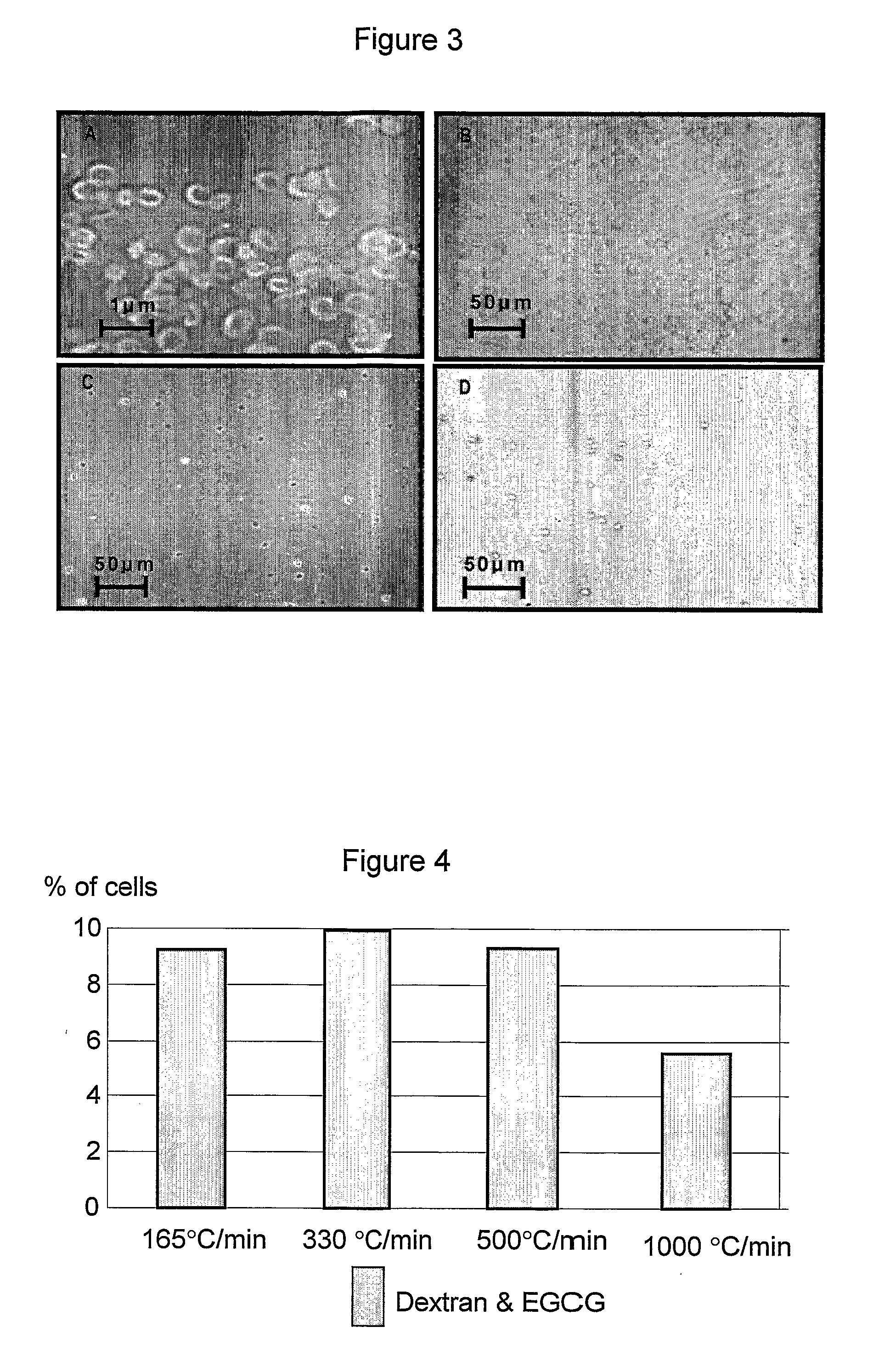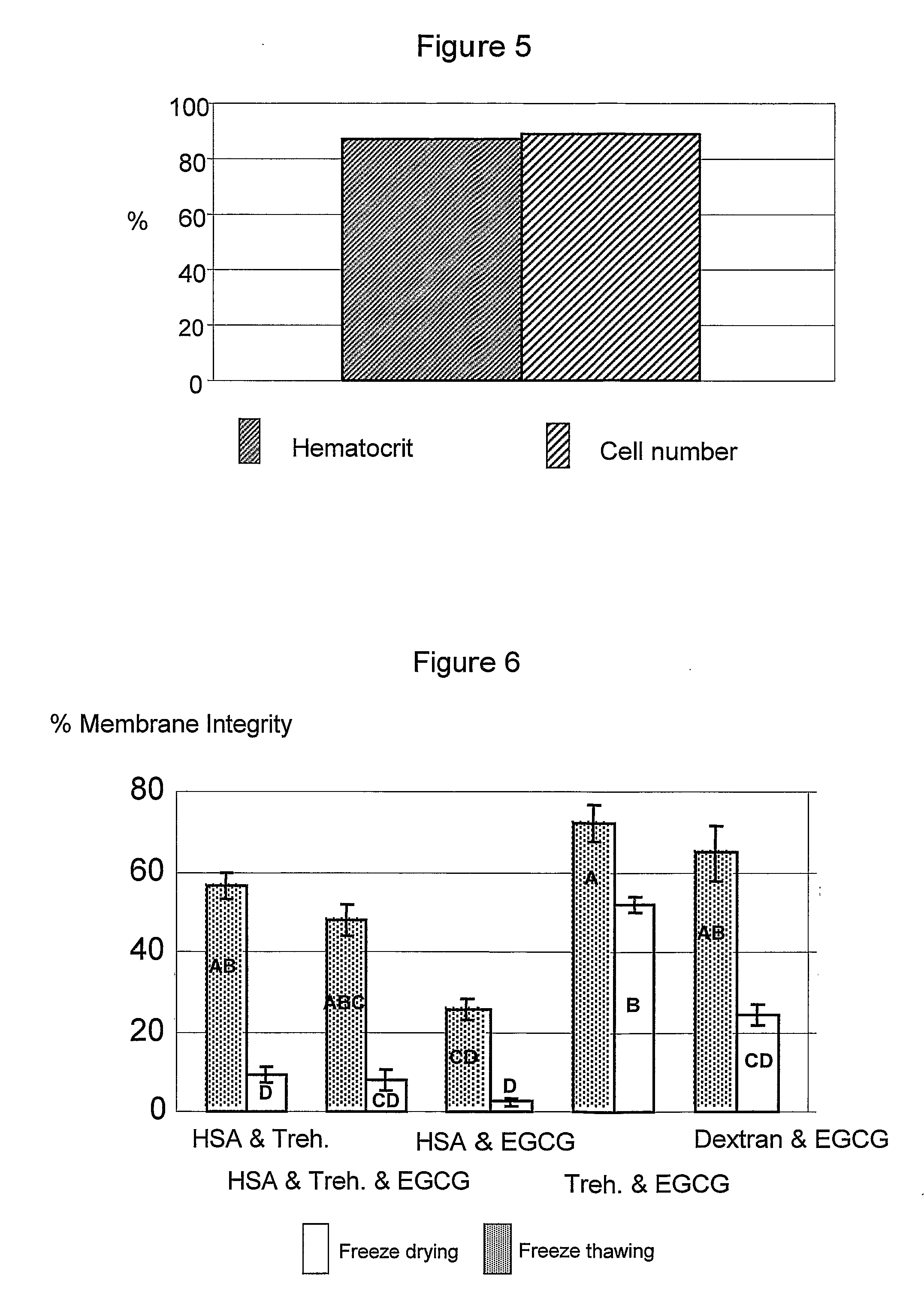Biological material and methods and solutions for preservation thereof
a biological material and biological technology, applied in the field of biological material preservation, can solve the problems of high concentration of potentially toxic cryoprotectant agents, inability to freeze blood supplies, and inability to meet the needs of emergency use,
- Summary
- Abstract
- Description
- Claims
- Application Information
AI Technical Summary
Benefits of technology
Problems solved by technology
Method used
Image
Examples
example 1
Freezing and Lyophilizing RBC at a Volume of 2.5 ml
[0105] Table II shows survival of RBC after freezing cells at 1,000 and 2,000° C. / min. Column 1A depicts the results for cells that were frozen at 1,000° C. / min and thawed but not lyophilized. Columns 1B depicts the results for cells that were frozen at 1,000° C. / min and lyophilized, and were then rehydrated using DDW. Columns 2A and 2B respectively depict the results for cells that were frozen at 2,000° C. / min and then either (A) thawed but not lyophilized or (B) lyophilized, and then rehydrated using DDW. The results are presented as the percentage of cells that survived from the total fresh cells counted. In these experiments the cell suspension volume was 2.5 ml.
[0106]FIG. 1 shows picture of samples that were frozen at 1,000° C. / min and stained using May-Gruenwald Giemsa after thawing as described above.
TABLE IIRBC survival after Cryopreservation at 1,000° C. / min1,000° C. / min2,000° C. / min1A1B2A2BSolutionThawedRehydratedThawe...
example 2
Freezing RBC at a Volume of 9 ml
[0108] RBC were frozen at a volume of 9 ml using the MTG freezing apparatus at different cooling rates of 500, 1000, 2000 and 2500° C. / min. Freezing solution was composed of 30% (w / v) dextran and 0.412 mM EGCG in PBS. Samples were thawed in a water bath at 37° C. After thawing, cells were counted using the Pentra60 (ABX, France) and morphological observation was conducted using May-Gruenwald Giemsa stain and light microscopy.
[0109] Results are shown in FIGS. 1 and 3, wherein we can see that samples frozen with a solution composed of EGCG and dextran had higher viability rates as detected by the Pentra60 machine. In addition, morphological evaluations also showed that RBC frozen with EGCG and dextran had a substantially normal morphological appearance.
example 3
Freezing RBC at a Volume of 50 ml
[0110] RBC were frozen at a volume of 50 ml. Freezing using the MTG freezing apparatus at different cooling rate of: 165, 330, 500 and 1000° C. / min. Freezing solution was composed of 30% (w / v) dextran and 0.412 mM EGCG in PBS. Thawing was done in a water bath at 37° C. Results are shown in FIG. 4.
[0111] The highest survival rate was achieved at a cooling rate of 330° C. / min. This cooling rate is lower than that of the best cooling rate in previous experiments. This difference may be due to the significantly high volume of the sample. In large volume the heat transfer is slower; therefore at very high cooling rates a more significant thermal gradient develops across the sample. One method of avoiding these temperature differences and achieving better heat transfer along the sample is the use of lower cooling rates.
PUM
| Property | Measurement | Unit |
|---|---|---|
| temperature | aaaaa | aaaaa |
| volume | aaaaa | aaaaa |
| temperatures | aaaaa | aaaaa |
Abstract
Description
Claims
Application Information
 Login to View More
Login to View More - R&D
- Intellectual Property
- Life Sciences
- Materials
- Tech Scout
- Unparalleled Data Quality
- Higher Quality Content
- 60% Fewer Hallucinations
Browse by: Latest US Patents, China's latest patents, Technical Efficacy Thesaurus, Application Domain, Technology Topic, Popular Technical Reports.
© 2025 PatSnap. All rights reserved.Legal|Privacy policy|Modern Slavery Act Transparency Statement|Sitemap|About US| Contact US: help@patsnap.com



